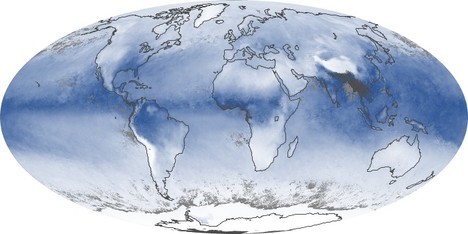Climate Illuminated

Water Vapor

NASA in a moment of weakness comes a bit clean on the role of water vapor in the atmosphere in the paper below.
Also shown is the complexity of the water vapor cycle.

Download an animation of this dataset (6 MB)

Water is constantly cycling through the atmosphere. Water evaporates from the Earth’s surface and rises on warm updrafts into the atmosphere. It condenses into clouds, is blown by the wind, and then falls back to the Earth as rain or snow. This cycle is one important way that heat and energy are transferred from the surface of the Earth to the atmosphere, and transported from one place to another on our planet.
Water vapor is also the most important greenhouse gas in the atmosphere. Heat radiated from Earth’s surface is absorbed by water vapor molecules in the lower atmosphere. The water vapor molecules, in turn, radiate heat in all directions. Some of the heat returns to the Earth’s surface. Thus, water vapor is a second source of warmth (in addition to sunlight) at the Earth’s surface.
These maps show the average amount of water vapor in a column of atmosphere in a given month. The units are given in centimeters, which is the equivalent amount of water that could be produced if all the water vapor in the column were to condense. The lowest amounts of water vapor (0 centimeters) appear in yellow, and the highest amounts (6 centimeters) appear in dark blue. Areas of missing data appear in shades of gray. The maps are based on data collected by the Moderate Resolution Imaging Spectroradiometer (MODIS) sensor on NASA’s Aqua satellite.
The most noticeable pattern in the time series is the influence of seasonal temperature changes and incoming sunlight on water vapor. In the tropics, a band of extremely humid air wobbles north and south of the equator as the seasons change. This band of humidity is part of the Intertropical Convergence Zone, where the easterly trade winds from each hemisphere converge and produce near-daily thunderstorms and clouds. Farther from the equator, water vapor concentrations are high in the hemisphere experiencing summer and low in the one experiencing winter.
Another pattern that shows up in the time series is that water vapor amounts over land areas decrease more in winter months than adjacent ocean areas do. This is largely because air temperatures over land drop more in the winter than temperatures over the ocean. Water vapor condenses more rapidly in colder air.
View, download, or analyze more of these data from NASA Earth Observations (NEO): Water Vapor
We should revisit occasionally what the proper role of government is. As the constitution was a good sense of direction, we need a core set of principles to add in order to deal with the future.
So many want to engineer society, remove risk, assist certain groups, rather than let individuals thrive and raise communities. Why?
Is Democracy where we all "get it good and hard" or is it the best means to a free society?
Should we roll with the special interests, or make the government achieve its proper role, what is that role, and how to do this?
When do deficits and governments become too large?
Government is becoming more elitist while trying to sell corrections to problems it created, what makes this possible?
This could also be inserted into the field above, or erased
Currently as a society, we are having a most difficult time discussing political issues. What is driving this? And why a rebirth in political culture would be a good thing.
Are "markets" dead as some would conjecture? Or is free enterprise what got us here?
At the heart of economics there are several possible economic schools of thought, the essence of these schools of thought and how they relate to our lives.